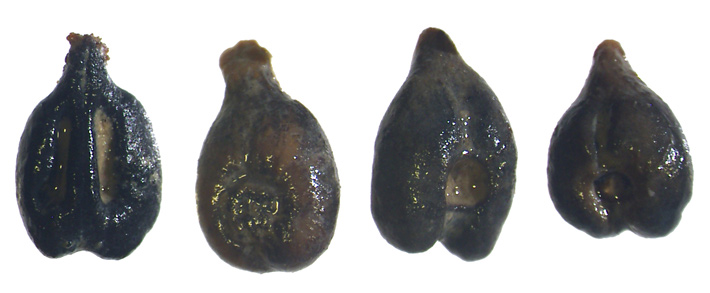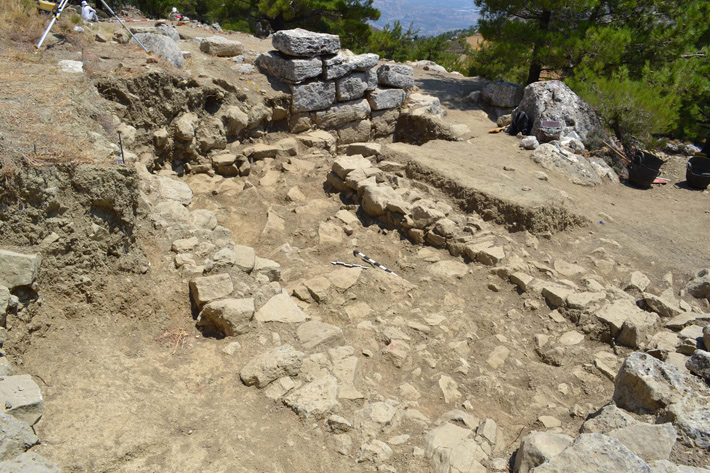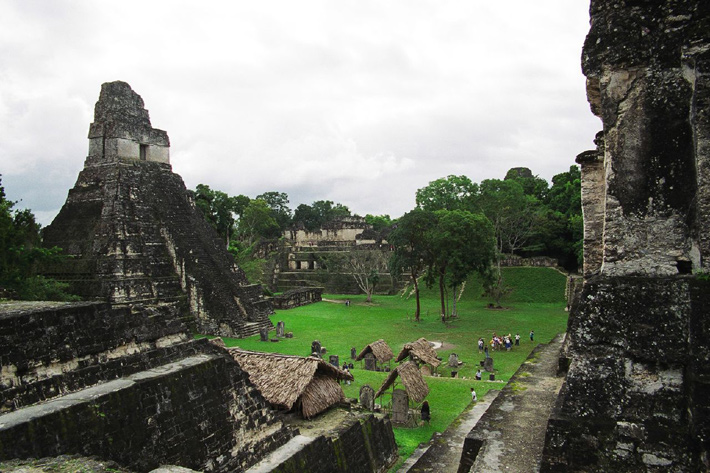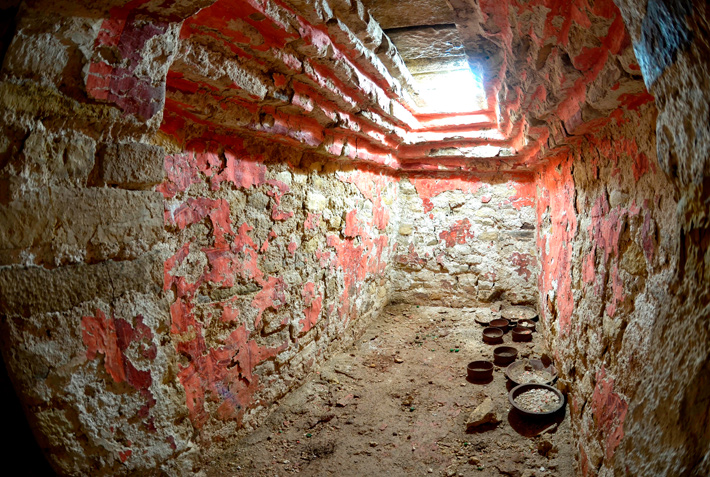From the Trenches
A Prehistoric Cocktail Party
By NIKHIL SWAMINATHAN
Thursday, February 07, 2013
 The 2012 holiday season brought news of several exciting finds from across Europe that make up a veritable cocktail party—including wine, beer, and cheese—of archaeological evidence.
The 2012 holiday season brought news of several exciting finds from across Europe that make up a veritable cocktail party—including wine, beer, and cheese—of archaeological evidence.
In a 2,000-year-old, 100-foot-deep well at the site of Cetamura del Chianti in Tuscany, Italy, archaeologists from Florida State University found 153 grape seeds. The pips date to the period shortly after the Romans claimed the site from the Etruscans. The researchers have identified the grapes as Vitis vinifera, or the wine grape. Because the seeds were not burned, they might carry preserved DNA that could offer insight into the beginnings of viticulture in the region now famous for its bold, fruity reds. “People are going to be interested in the variety of grapes we might be able to identify,” says archaeologist Nancy Thomson de Grummond.
Meanwhile, in western Cyprus, a domed, mud-plaster structure found at the site of Kissonerga-Skalia appears to have been used as a Bronze Age kiln to dry malt for brewing beer. Archaeologist Lindy Crewe of the University of Manchester in England and her team excavated the nearly 4,000-year-old oven, uncovering ashy deposits containing carbonized fig seeds, mortars and other grinding implements, and juglets. They also found sherds of a large clay pot that they believe was a pithos, a vessel in which a fire was lit and used as an indirect heat source within the kiln. Malt, the team hypothesizes, might have been stored in the juglets while they were in the kiln, and then removed to perform the rest of the brewing process.
Finally, new data indicate that sherds from vessels used as sieves, dating back to the sixth millennium B.C. in Poland, have residue of dairy fats on them, suggesting they were used in the earliest known instance of cheese-making. Researchers at the University of Bristol confirmed what Princeton archaeologist Peter Bogucki had suspected for 30 years—that Neolithic farmers in Europe whose settlements were dominated by remains of cattle were dependent on those animals for more than meat.
Taken together, the finds, spanning thousands of years and distant locations, suggest that tastes may not have changed all that much over the millennia.
Minoan Mountaintop Manse
By YANNIS STAVRAKAKIS
Thursday, February 07, 2013
 In 1898, archaeologist Sir Arthur Evans visited a small plateau near the town of Ierapetra in southeastern Crete, where he documented in his now-lost diary the remains of a Minoan fort. For almost a century there was no further exploration of the site, called Anatoli, until last summer, when a team from the University of Athens began digging there. Over more than a month, the team unearthed new evidence suggesting that the structure was not, in fact, a defensive fort, but rather a well-preserved two-story villa dating to the New Palace period (1600–1450 B.C.). In addition to walls more than seven feet high, archaeologists also uncovered an impressive stone facade, a room filled with large storage pithoi (ceramic containers), a rock-crystal bead, a bronze ax, and a pillar crypt—a distinctively Minoan ritual structure. Rural villas of this type have been uncovered in Crete before, but they were all situated in the lowlands and plains. Thus the Anatoli villa, at almost 9,000 feet, is only the second to be found at such a high altitude. Excavation director Yiannis Papadatos suggests that it likely functioned as a regional administrative and economic center. Until now, Minoan scholars have focused largely on the island’s lowlands and coastline. In the coming seasons, the team hopes to further explore the role of Minoan mountaintop settlements.
In 1898, archaeologist Sir Arthur Evans visited a small plateau near the town of Ierapetra in southeastern Crete, where he documented in his now-lost diary the remains of a Minoan fort. For almost a century there was no further exploration of the site, called Anatoli, until last summer, when a team from the University of Athens began digging there. Over more than a month, the team unearthed new evidence suggesting that the structure was not, in fact, a defensive fort, but rather a well-preserved two-story villa dating to the New Palace period (1600–1450 B.C.). In addition to walls more than seven feet high, archaeologists also uncovered an impressive stone facade, a room filled with large storage pithoi (ceramic containers), a rock-crystal bead, a bronze ax, and a pillar crypt—a distinctively Minoan ritual structure. Rural villas of this type have been uncovered in Crete before, but they were all situated in the lowlands and plains. Thus the Anatoli villa, at almost 9,000 feet, is only the second to be found at such a high altitude. Excavation director Yiannis Papadatos suggests that it likely functioned as a regional administrative and economic center. Until now, Minoan scholars have focused largely on the island’s lowlands and coastline. In the coming seasons, the team hopes to further explore the role of Minoan mountaintop settlements.
Mapping Maya Cornfields
By KATHERINE SHARPE
Monday, February 11, 2013
 Archaeologists have wondered for decades how the ancient Maya, who maintained large cities in hilly territory covered with rain forest and thin soil, were able to produce enough food to support their numbers. “That’s the Maya mystery,” says Richard Terry, a Brigham Young University soil scientist whose work explores the agricultural methods of the civilization. In an excavation at Tikal, Guatemala, once a Maya settlement of some 60,000 people, Terry’s interdisciplinary team is constructing a map of where and when the 115-square-mile site was planted with corn, one of the Maya’s staple crops. Corn leaves distinctive traces in the soil, which the team revealed using mass spectrometry. Understanding how the Maya made use of the land could reveal how they fed their large populations and whether agricultural shortfalls hastened the decline of the civilization.
Archaeologists have wondered for decades how the ancient Maya, who maintained large cities in hilly territory covered with rain forest and thin soil, were able to produce enough food to support their numbers. “That’s the Maya mystery,” says Richard Terry, a Brigham Young University soil scientist whose work explores the agricultural methods of the civilization. In an excavation at Tikal, Guatemala, once a Maya settlement of some 60,000 people, Terry’s interdisciplinary team is constructing a map of where and when the 115-square-mile site was planted with corn, one of the Maya’s staple crops. Corn leaves distinctive traces in the soil, which the team revealed using mass spectrometry. Understanding how the Maya made use of the land could reveal how they fed their large populations and whether agricultural shortfalls hastened the decline of the civilization.
The findings, published in the Soil Science Society of America Journal, show evidence that the Maya planted corn in lowland areas where there was more soil, and that agriculture gradually spread up-slope to thinner soils, where erosion eventually undermined productivity. The next question, says Terry, is whether the Maya developed the capability to cultivate corn in the low-lying wetlands, or bajos, that ring the site. If the Maya did possess a “lost technology” for growing corn in swampy conditions, the Maya crop mystery could constitute a new puzzle, as well as, perhaps, prove useful to modern agriculture.
Inside a Painted Tomb
By ZACH ZORICH
Monday, February 11, 2013
 A team of archaeologists from Mexico’s National Institute of Anthropology and History has entered a brilliantly painted Maya tomb inside Palenque’s Temple 20, 13 years after it was first discovered, following consultation with dozens of specialists on how best to conserve the find. The tomb is believed to hold the remains of K’uk Bahlam I, the founder of the city’s ruling dynasty, who came to the throne in A.D. 431. In 2011, a camera was lowered through a small hole in the tomb’s ceiling, providing a tantalizing glimpse of the murals (see “A Peek Inside Two Secret Chambers,” September/October 2011). The paintings, which may depict the nine lords of the Maya underworld, will be stabilized and conserved before the tomb is further excavated.
A team of archaeologists from Mexico’s National Institute of Anthropology and History has entered a brilliantly painted Maya tomb inside Palenque’s Temple 20, 13 years after it was first discovered, following consultation with dozens of specialists on how best to conserve the find. The tomb is believed to hold the remains of K’uk Bahlam I, the founder of the city’s ruling dynasty, who came to the throne in A.D. 431. In 2011, a camera was lowered through a small hole in the tomb’s ceiling, providing a tantalizing glimpse of the murals (see “A Peek Inside Two Secret Chambers,” September/October 2011). The paintings, which may depict the nine lords of the Maya underworld, will be stabilized and conserved before the tomb is further excavated.
Life (According to Gut Microbes)
By NIKHIL SWAMINATHAN
Monday, February 11, 2013
 Each of us is home to a vibrant community of gut microbes, the bacteria that live in our digestive systems. Because these bacteria often reflect the diets of their hosts, scientists are examining coprolites—fossilized feces—to learn more about the microbiomes, and lives, of ancient humans.
Each of us is home to a vibrant community of gut microbes, the bacteria that live in our digestive systems. Because these bacteria often reflect the diets of their hosts, scientists are examining coprolites—fossilized feces—to learn more about the microbiomes, and lives, of ancient humans.
For instance, the abundance of the bacteria Bifidobacterium breve—commonly found in the stool of recently breastfed children—in a 1,400-year-old sample taken from La Cueva de los Chiquitos Muertos (“The Cave of Dead Children”) in northern Mexico suggests the coprolite had come from a young child. The sample also contained a large quantity of a bacteria called Prevotella, which indicates a diet heavy in carbohydrates but relatively low in proteins.
Cecil M. Lewis, Jr., a molecular anthropologist at the University of Oklahoma, and his team also found Treponema in both ancient samples and modern rural populations. He thinks this implies that both groups have diets heavy in raw, fibrous foods. The microbe, however, does not appear in the stool of urban or Western populations, which might be attributable to more sanitary living conditions. “As we learn more about how well these microbiome profiles predict aspects of the human condition,” says Lewis, “we can use the information to better understand the past.”
Advertisement
Advertisement
IN THIS ISSUE
Features
Pirates of the Original Panama Canal
Archaeology Island
A Soldier's Story
Letter from Cambodia
From the Trenches
Saving Northern Ireland's Noble Bog
Off the Grid
Mussel Mass in Lake Ontario
Europe's First Carpenters
Medici Mystery
Deconstructing a Zapotec Figurine
Messages from Quarantine
Let Slip the Pigeons of War
The First Spears
Burials and Reburials in Ancient Pakistan
Life (According to Gut Microbes)
Mapping Maya Cornfields
Inside a Painted Tomb
Minoan Mountaintop Manse
A Prehistoric Cocktail Party
Advertisement

Recent Issues
-
 May/June 2024
May/June 2024
-
 March/April 2024
March/April 2024
-
 January/February 2024
January/February 2024
-
 November/December 2023
November/December 2023
-
 September/October 2023
September/October 2023
-
 July/August 2023
July/August 2023
-
 May/June 2023
May/June 2023
-
 March/April 2023
March/April 2023
-
 January/February 2023
January/February 2023
-
 November/December 2022
November/December 2022
-
 September/October 2022
September/October 2022
-
 July/August 2022
July/August 2022
-
 May/June 2022
May/June 2022
-
 March/April 2022
March/April 2022
-
 January/February 2022
January/February 2022
-
 November/December 2021
November/December 2021
-
 September/October 2021
September/October 2021
-
 July/August 2021
July/August 2021
-
 May/June 2021
May/June 2021
-
 March/April 2021
March/April 2021
-
 January/February 2021
January/February 2021
-
 November/December 2020
November/December 2020
-
 September/October 2020
September/October 2020
-
 July/August 2020
July/August 2020
-
 May/June 2020
May/June 2020
-
 March/April 2020
March/April 2020
-
 January/February 2020
January/February 2020
-
 November/December 2019
November/December 2019
-
 September/October 2019
September/October 2019
-
 July/August 2019
July/August 2019
-
 May/June 2019
May/June 2019
-
 March/April 2019
March/April 2019
-
 January/February 2019
January/February 2019
-
 November/December 2018
November/December 2018
-
 September/October 2018
September/October 2018
-
 July/August 2018
July/August 2018
-
 May/June 2018
May/June 2018
-
 March/April 2018
March/April 2018
-
 January/February 2018
January/February 2018
-
 November/December 2017
November/December 2017
-
 September/October 2017
September/October 2017
-
 July/August 2017
July/August 2017
-
 May/June 2017
May/June 2017
-
 March/April 2017
March/April 2017
-
 January/February 2017
January/February 2017
-
 November/December 2016
November/December 2016
-
 September/October 2016
September/October 2016
-
 July/August 2016
July/August 2016
-
 May/June 2016
May/June 2016
-
 March/April 2016
March/April 2016
-
 January/February 2016
January/February 2016
-
 November/December 2015
November/December 2015
-
 September/October 2015
September/October 2015
-
 July/August 2015
July/August 2015
-
 May/June 2015
May/June 2015
-
 March/April 2015
March/April 2015
-
 January/February 2015
January/February 2015
-
 November/December 2014
November/December 2014
-
 September/October 2014
September/October 2014
-
 July/August 2014
July/August 2014
-
 May/June 2014
May/June 2014
-
 March/April 2014
March/April 2014
-
 January/February 2014
January/February 2014
-
 November/December 2013
November/December 2013
-
 September/October 2013
September/October 2013
-
 July/August 2013
July/August 2013
-
 May/June 2013
May/June 2013
-
 March/April 2013
March/April 2013
-
 January/February 2013
January/February 2013
-
 November/December 2012
November/December 2012
-
 September/October 2012
September/October 2012
-
 July/August 2012
July/August 2012
-
 May/June 2012
May/June 2012
-
 March/April 2012
March/April 2012
-
 January/February 2012
January/February 2012
-
 November/December 2011
November/December 2011
-
 September/October 2011
September/October 2011
-
 July/August 2011
July/August 2011
-
 May/June 2011
May/June 2011
-
 March/April 2011
March/April 2011
-
 January/February 2011
January/February 2011
Advertisement






